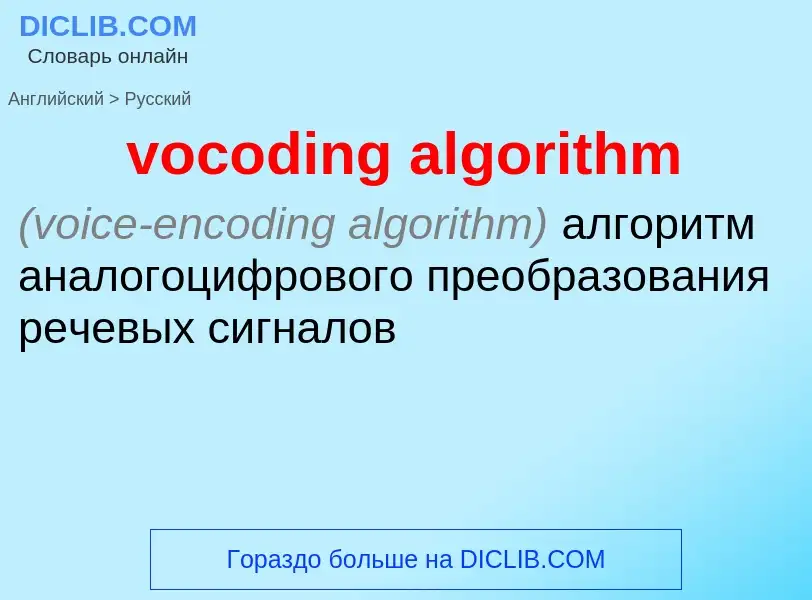Перевод и анализ слов искусственным интеллектом ChatGPT
На этой странице Вы можете получить подробный анализ слова или словосочетания, произведенный с помощью лучшей на сегодняшний день технологии искусственного интеллекта:
- как употребляется слово
- частота употребления
- используется оно чаще в устной или письменной речи
- варианты перевода слова
- примеры употребления (несколько фраз с переводом)
- этимология
vocoding algorithm - перевод на Английский
математика
алгоритмический метод
['ælgərið(ə)m]
общая лексика
алгоритм
математическая функция или конечный набор описаний конкретной последовательности действий (правил), необходимых для того, чтобы компьютер или интеллектуальное устройство выполнили за конечное время некоторую задачу, сжатие изображения, выбор оптимального маршрута пересылки пакета или шифрование данных. Алгоритм может быть описан блок-схемой. Термин происходит от имени древнеперсидского математика Мухаммеда ибн Муса аль Харезми, написавшего трактат, посвященный алгоритмическому методу
метод, правило
синоним
существительное
специальный термин
алгоритм
- access algorithm
- anti-virus algorithm
- approximate algorithm
- assymetric algorithm
- audio scrambling algorithm
- authentication algorithm
- B-Crypt algorithm
- block cipher algorithm
- block-encryption algorithm
- bit sequence generating algorithm
- breaking algorithm
- cipher algorithm
- ciphering algorithm
- classified algorithm
- code-breaking algorithm
- coding algorithm
- collision resolution algorithm
- combinaforial algorithm
- compression algorithm
- confidentiality algorithm
- correlation algorithm
- crypt algorithm
- cryption algorithm
- cryptoanalytic algorithm
- cryptographic algorithm
- data authentication algorithm
- data encryption algorithm
- data reduction algorithm
- DEA algorithm
- decoding algorithm
- DES algorithm
- deterministic algorithm
- dichotomic algorithm
- digital encryption algorithm
- digital signature algorithm
- double-key algorithm
- double transposition algorithm
- dual key algorithm
- e-d algorithm
- encryption algorithm
- encryption-decryption algorithm
- error correction algorithm
- Euclidean algorithm
- Euclid's algorithm
- exponential time algorithm
- exponentiation algorithm
- factoring algorithm
- factorization algorithm
- fast data encryption algorithm
- FEAL algorithm
- fixed algorithm
- Fourier transform algorithm
- handshaking algorithm
- hashing algorithm
- heuristic algorithm
- international encryption algorithm
- key-controlled algorithm
- key-dependent algorithm
- key distribution algorithm
- key generation algorithm
- key input algorithm
- keyed algorithm
- key exchange algorithm
- key expansion algorithm
- key management algorithm
- key shedule algorithm
- key stream algorithm
- knapsack algorithm
- linear predictive coding algorithm
- linear sieve algorithm
- meet-in-the-middle algorithm
- message authentification algorithm
- message digest algorithm
- modification defection encryption algorithm
- modular algorithm
- modular multiplication algorithm
- non-linear algorithm
- one-way encryption algorithm
- password algorithm
- password cracking algorithm
- password encryption algorithm
- password generation algorithm
- permutation algorithm
- polynomial algorithm
- polynomial time algorithm
- predicting algorithm
- prediction algorithm
- primality testing algorithm
- private cryptographic algorithm
- probabilistic algorithm
- proprietary encryption algorithm
- protection algorithm
- protection mechanism algorithm
- p-time algorithm
- public key algorithm
- quadratic sieve factoring algorithm
- Rivest-Shamir-Adleman algorithm
- public transformation algorithm
- quaternary DES algorithm
- randomizing algorithm
- recognition algorithm
- recursive algorithm
- routing algorithm
- RSA algorithm
- RSA B safe algorithm
- scrambling algorithm
- search algorithm
- secret key algorithm
- secret transformation algorithm
- SEEK algorithm
- secure exchange of keys algorithm
- shortest path algorithm
- sieve algorithm
- signal processing algorithm
- signal reconstruction algorithm
- signature algorithm
- single-key algorithm
- solving algorithm
- standard encryption algorithm
- standardized encryption algorithm
- stream cipher algorithm
- strong algorithm
- substitution algorithm
- substitution-permutation encryption algorithm
- transformational algorithm
- unbreakable algorithm
- user-modified algorithm
- verification algorithm
- Vitterbi algorithm
- vocoding algorithm
- voice-digitising algorithm
- voice encoding algorithm
математика
алгоритм кодирования
кодирующий алгоритм
- almost-dual algorithm
- approximation algorithm
- best-route algorithm
- composite simplex algorithm
- control algorithm
- decomposition algorithm
- dual algorithm
- dual simplex algorithm
- estimation algorithm
- maximin algorithm
- minimax algorithm
- network algorithm
- operative algorithm
- optimal path algorithm
- optimization algorithm
- prediction algorithm
- primal algorithm
- primal-dual algorithm
- search algorithm
- shortest route algorithm
- transportation algorithm
- verification algorithm
Википедия
The Tonelli–Shanks algorithm (referred to by Shanks as the RESSOL algorithm) is used in modular arithmetic to solve for r in a congruence of the form r2 ≡ n (mod p), where p is a prime: that is, to find a square root of n modulo p.
Tonelli–Shanks cannot be used for composite moduli: finding square roots modulo composite numbers is a computational problem equivalent to integer factorization.
An equivalent, but slightly more redundant version of this algorithm was developed by Alberto Tonelli in 1891. The version discussed here was developed independently by Daniel Shanks in 1973, who explained:
My tardiness in learning of these historical references was because I had lent Volume 1 of Dickson's History to a friend and it was never returned.
According to Dickson, Tonelli's algorithm can take square roots of x modulo prime powers pλ apart from primes.


![Alan Turing's statue at [[Bletchley Park]] Alan Turing's statue at [[Bletchley Park]]](https://commons.wikimedia.org/wiki/Special:FilePath/Alan Turing.jpg?width=200)






![compass]] in a painting of about 1474. compass]] in a painting of about 1474.](https://commons.wikimedia.org/wiki/Special:FilePath/Euklid.jpg?width=200)

